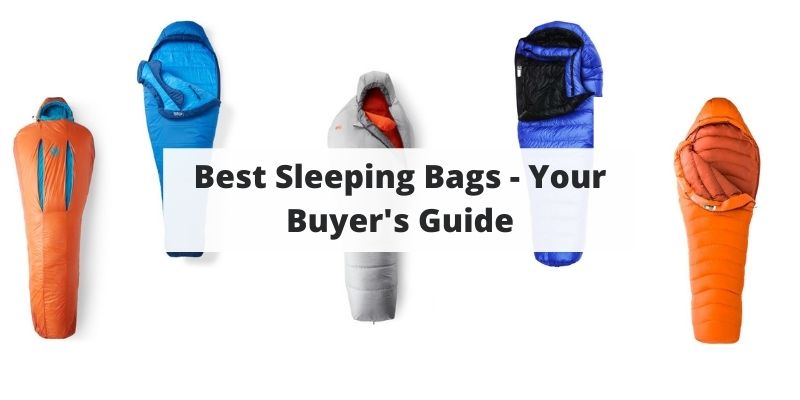There is nothing quite like the feeling of being cozy in a sleeping bag while sleeping outside. However, choosing the right sleeping bag for your backpacking or camping trip can make or break your next adventure. Whether you are car camping or going on an epic journey into the wilderness, there is a sleeping bag that is tailored to your needs. This article will inform you on what factors are important to help narrow down the best sleeping bag options for you.
Quick Navigation:
Key Considerations | Best Sleeping Bags Under $200 | Best Overall Sleeping Bags
Best Sleeping Bags Under $200
Kelty Cosmic 20
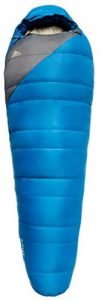 This is an awesome back for the price point. You retain quality materials and durability with this bag, but lose a bit in terms of weight and stuff size compared to more expensive options.
This is an awesome back for the price point. You retain quality materials and durability with this bag, but lose a bit in terms of weight and stuff size compared to more expensive options.
If you are a beginner, on a budget, or frequently car camp and will only be using this for the occasional simple backpacking trip, this is a really great option.
There are reports of the zipper getting caught sometimes on this bag which can be a little frustrating.
Weight:
Long: 2 lbs. 10.7 oz.
Regular: 2 lbs. 6.6 oz.
Short: 2 lbs. 3.9 oz.
Price Range: $140-$180
Marmot Trestles Elite Eco 20
 This bag is for the budget friendly backpacker looking for a 3 season bag. It is designed well with quality zippers, synthetic insulation, a nice hood, and an insulated footbox. This bag will keep you warm above 20 degrees, will pack down relatively nicely (not like higher end bags) and still weighs little enough for most backpackers. If you are looking for a quality budget friendly sleeping bag with great reviews, this is a solid option.
This bag is for the budget friendly backpacker looking for a 3 season bag. It is designed well with quality zippers, synthetic insulation, a nice hood, and an insulated footbox. This bag will keep you warm above 20 degrees, will pack down relatively nicely (not like higher end bags) and still weighs little enough for most backpackers. If you are looking for a quality budget friendly sleeping bag with great reviews, this is a solid option.
Weight: 2 Pounds 6 Ounces (1,077 grams)
Temperature Limit: 21.6 degrees (F)
Price: $149-$160
Insulation: Synthetic
Klymit 0 Degree Full Synthetic Sleeping Bag
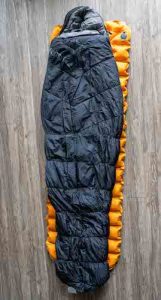 This full synthetic sleeping bag is super warm, fluffy, budget friendly, and feels equivalent to some of the highest end sleeping bags on the market. It has quality zippers, great comfort, awesome full mummy design, and is one of the few full synthetic 0 degree bags at this price point. All in all, this is one of the comfiest bags on the market. The only downside to this bag is the relatively large pack size and heavy weight.
This full synthetic sleeping bag is super warm, fluffy, budget friendly, and feels equivalent to some of the highest end sleeping bags on the market. It has quality zippers, great comfort, awesome full mummy design, and is one of the few full synthetic 0 degree bags at this price point. All in all, this is one of the comfiest bags on the market. The only downside to this bag is the relatively large pack size and heavy weight.
| Weight | 4.7 lbs / 2.1 kg |
| Dimensions | 82 x 30 in / 208 x 76 cm |
| Packed Dimensions | 18.25 x 11 x 11 in / 46 x 28 x 28 cm |
| Insulation Type | Synthetic Down-like (ClusterLoft) |
| Temperature Rating | 2 Years |
| Warranty | 0 F / -18 C |
Price: $149-$189
Hyke & Byke Katahdin 15 Degree & 0 Degree Synthetic Down Bag
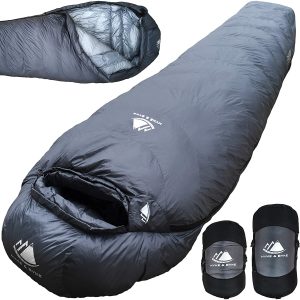 This is a budget friendly synthetic bag that is made with really high quality materials. It is designed with users in mind. Many details were thought out, like an internal phone slot within the bag, quality zippers, and a comfortable and warm design.
This is a budget friendly synthetic bag that is made with really high quality materials. It is designed with users in mind. Many details were thought out, like an internal phone slot within the bag, quality zippers, and a comfortable and warm design.
This bag is heavier than other comparable options due to the synthetic down, but this allows you to save some dollars while still getting an extremely warm bag.
WIth hundreds of reviews on Amazon, this is another item backed by happy campers.
Price: $120 – $130
Nemo Kyan 35
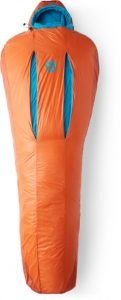 This synthetic bag is a lightweight, affordable and durable option for those looking for a summer or warm weather bag. While you aren’t going to get the super warmth out of this bag, if your needs don’t go into lower temperatures, this is a fantastic option. This bag packs very small, so this is a great lightweight option for those warmer backpacking trips.
This synthetic bag is a lightweight, affordable and durable option for those looking for a summer or warm weather bag. While you aren’t going to get the super warmth out of this bag, if your needs don’t go into lower temperatures, this is a fantastic option. This bag packs very small, so this is a great lightweight option for those warmer backpacking trips.
Price: This bag is under $200 but can be found in the $150-$175 range occasionally during discounts.
Weight:
Long – 1 lb. 13 oz.
Regular – 1 lb. 12 oz.
Compressed Volume:
Long – 3.7 liters
Regular – 3.41 liters
Best Overall Sleeping Bags
REI Co-op Magma 15 & 30
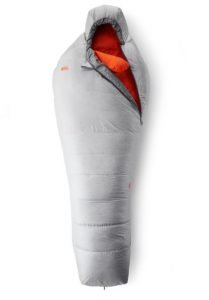 The combination of low weight, small pack size, and comfort makes this bag perform at very high levels for its mid range price. It features a quality design, well made zipper system, responsible down, and comes in a 15 degree of 30 degree rating.
The combination of low weight, small pack size, and comfort makes this bag perform at very high levels for its mid range price. It features a quality design, well made zipper system, responsible down, and comes in a 15 degree of 30 degree rating.
Based on reviews of this bag, the comfort ratings on these temperatures are a bit higher than stated. More like 40 degrees and 25 degrees respectively. With this being said, this is a great value bag with a ton of versatility. Coming from REI, you’ll be sure to get quality customer service as well.
Weight: 1 lb. 12 oz. (30 degree) / 1 lb. 3.8 oz. (15 degree)
See Magma 15 On REI | See Magma 30 On REI
Western Mountaineering UL
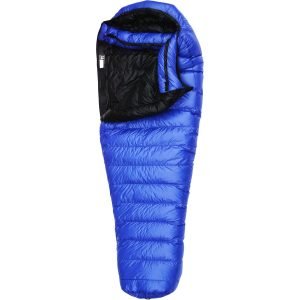 This bad is an extremely warm, 850 goose down mummy style bag. It has 1 pound (16 ounces of down) insulation, great design, and tons of happy customers that have left quality reviews. While this bag is on the more expensive side, it is one of those durable and high end solutions sure to keep you warm. This is an extremely lightweight bag with high end performance at 1 lb. 13 oz. Total Weight.
This bad is an extremely warm, 850 goose down mummy style bag. It has 1 pound (16 ounces of down) insulation, great design, and tons of happy customers that have left quality reviews. While this bag is on the more expensive side, it is one of those durable and high end solutions sure to keep you warm. This is an extremely lightweight bag with high end performance at 1 lb. 13 oz. Total Weight.
This bag has 3 different length options as well.
Price Range: $510 – $540
| Shape | Size (ft/in) | Rating | Loft (in) | Inside Girth shdr/hip/foot (in) |
Fill Wt. | Total Wt. | Stuff size (in) | Sac Size |
| Mummy (w/ full collar) |
5’6″ (165 cm) | 20° F (-7° C) | 5.5″ (14 cm) | 59″/51″/38″ | 15 oz | 1 lb 12 oz | 7″x13″ | XS |
| 6’0″ (180 cm) | 20° F (-7° C) | 5.5″ (14 cm) | 59″/51″/38″ | 16 oz | 1 lb 13 oz | 7″x13″ | XS | |
| 6’6″ (200 cm) | 20° F (-7° C) | 5.5″ (14 cm) | 60″/52″/38″ | 17 oz | 1 lb 15 oz | 7″x13″ | XS |
Marmot Lithium Sleeping Bag (0 Degree)
 If you are looking for a winter capable sleeping bag, the Marmot Lithium is one of the best options out their. It is extremely lightweight for the warmth at less than 3 pounds for either size. It features a quality zipper system, 800 down, a nice footbox, and a durable outer material. If you need a backpacking pack that packs small, is lightweight, and will keep you warm, this is a great option.
If you are looking for a winter capable sleeping bag, the Marmot Lithium is one of the best options out their. It is extremely lightweight for the warmth at less than 3 pounds for either size. It features a quality zipper system, 800 down, a nice footbox, and a durable outer material. If you need a backpacking pack that packs small, is lightweight, and will keep you warm, this is a great option.
Weight:
Regular: 2lb 10oz
Long: 2lb 13oz
Price: $500=$550
View On Backcountry | View On REI | View On Marmot | View On Amazon
Key Considerations Before Choosing A Sleeping Bag
Activity: Determining Weight & Pack Size
Just like any other piece of technical outdoor gear, the type of sleeping bag should match the activity you are doing. If car camping is the primary activity, weight is not an issue so you can get a nice heavy sleeping bag that is extremely comfortable. On the contrary, if you are an alpine climber or backcountry skier, you want to make sure you have a great warm but lightweight bag due to carrying it in your pack and sleeping in extremely cold temperatures. That being said, there’s no need to go buy a sleeping bag specific for every activity (unless you want to). Most people opt to get a couple sleeping bags that will cover most of the conditions they will be camping out in.
Sleeping Bag Weights: Most backpacking sleeping bags will be under 2 pounds. If you are looking for a super warm bag (0 degrees), you may be looking for something less than 3 pounds. Read our full guide on sleeping bag weight.
Stuff Size: When you are comparing top picks, you’ll want to pay close attention to the stuff size of the bag. How much space is this going to take up in your bag? Obviously, the smaller the stuff size, the more room their is for other gear. This can vary greatly by size, style, temperature rating and fill material, so compare similar style bags when deciding.
Air Temperature – Determining Temperature Rating
Choosing the right heat value sleeping bag to match the surrounding temperature is likely the most important factor when deciding on the best bag for your needs. A common thing to do is to purchase a bag that covers most of the temperature range you’ll be sleeping in. For example, if you like to camp in a temperate climate during the spring, summer, and fall, a sleeping bag rated down to 20 degrees Fahrenheit will keep you warm in those conditions. A 20 degree sleeping bag (or a bag rated around that temperature) can be commonly referred to as a “three-season sleeping bag”. A “summer sleeping bag” is usually rated to around 40 degrees, and a “winter sleeping bag” can vary depending on how extreme the temperatures are. A warm sleeping bag is generally -20 or 0 degrees. The warmest sleeping bag on the market is rated for -60 degrees!
If the lowest temperature for your trip is 30 degrees Fahrenheit, a 20 degree sleeping bag will keep you nice and toasty. Alternatively, if you are sleeping in a 40 degree bag during a night that drops to 30 degrees, you will be very cold and uncomfortable. Usually, a 40 degree bag is considered a “summer sleeping bag”, since 40 degrees is around the lowest temperature during that time of year. If this is the only sleeping bag in your arsenal, sleeping in warm layers and blankets during temperatures below 40 degrees can help you manage those chilly nights.
Climate – Choosing Goose Down Vs Synthetic
Goose down and synthetic (non-organic fiber blend) are the two main types insulation within sleeping bags that vary in performance based on the climate where you recreate. If the area is primarily wet, humid, or variable, a synthetic sleeping bag may be the best option. This is because goose-down, although it is extremely warm, can lose its loft due to clumping and does not retain heat when saturated. Down insulation also takes considerably more time to dry out versus synthetic. However, if you plan to do spend the majority of your time in arid or frigid environments, down insulation is the way to go.
Goose Down tends to pack better and keep bags lighter of the same rating, so the most packable and lightest bags are goose down instead of synthetic. Read about the differences in here.
Style – Tall Vs. Short And Mummy Vs Square
Sleeping bags also come in various shapes and sizes. When selecting your new bag, it is important to realize that there is a size range for each model. If you are a considerably tall or short person, reference the sizing chart before purchasing.
Another factor when choosing the style of your new sleeping bag is to go with a tapered “mummy style” bag or something more open like a backcountry quilt. Since mummy bags have significantly less fabric, they are lighter than a traditional square bag. These bags are generally warmer than a traditional bag due to their closer proximity to a person’s profile. For ultralight thru-hikers, a backcountry quilt might be more appropriate due to their lightweight material, packability, and the nature of thru-hikers generally camping in warm temperatures.
Some sleeping bags feature various zipper styles. These zipper styles can affect the amount of heat retention each bag provides. A full length zipper, although it is the easiest to get in and out of, has the least amount of heat retention due to the porous space of the zipper’s teeth. For those people who love the ability to vent out their excess body heat at night, the full length zipper is an ideal choice. There are also half-zippers and three-quarter zippers. Half-zippers provide the most amount of heat retention but are kind of tricky to get in and out of. The three-quarter zip seems to be a good middle ground between the full and half zipper options because of their solid heat retention, ease of access, and ability to vent excess heat.
Our Testing Methodology & Expertise
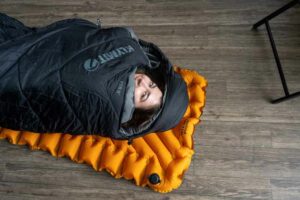 Our team has tested over a dozen sleeping bags in order to help make the best recommendations. We have combed through hundreds of reviews on each sleeping bag model, and even picked up, unpacked, and tested bags in the store! While testing our bags, we were looking at some key elements:
Our team has tested over a dozen sleeping bags in order to help make the best recommendations. We have combed through hundreds of reviews on each sleeping bag model, and even picked up, unpacked, and tested bags in the store! While testing our bags, we were looking at some key elements:
- Overall value (price to quality ratio)
- Synthetic Insulation vs Down
- Temperature Ratings
- Comfort
- Durability
- Packed size
- Weight
- Reviews from customers and our colleagues
We are a team of backpackers, car campers, boondockers, and even hammock campers. Through the years we have had lots of sleepless nights, uncomfortable nights, cold nights, wet nights, and hot nights. These experiences put us in a great position to recommend the top sleeping bags on the market. By leveraging real world experiences in combination with testing multiple bags sitting in the living room for a fair comparison, we came up with some great insights.
Conclusion
Sleeping bags are important in helping guarantee a great trip in the woods. Hopefully by now, discussing these topics have begun to form a frame of reference for what type of bag will be best for you. If you still don’t know what bag is the best match for your upcoming trip, head to your local gear shop to see the true size, shape, and feel of each product.
Max DesMarais is the founder of hikingandfishing.com. He has a passion for the outdoors and making outdoor education and adventure more accessible. Max is a published author for various outdoor adventure, travel, and marketing websites. He is an experienced hiker, backpacker, fly fisherman, backcountry skier, trail runner, and spends his free time in the outdoors. These adventures allow him to test gear, learn new skills, and experience new places so that he can educate others. Max grew up hiking all around New Hampshire and New England. He became obsessed with the New Hampshire mountains, and the NH 48, where he guided hikes and trail runs in the White Mountains. Since moving out west, Max has continued climbed all of the Colorado 14ers, is always testing gear, learning skills, gaining experience, and building his endurance for outdoor sports. You can read more about his experience here: hikingandfishing/about

